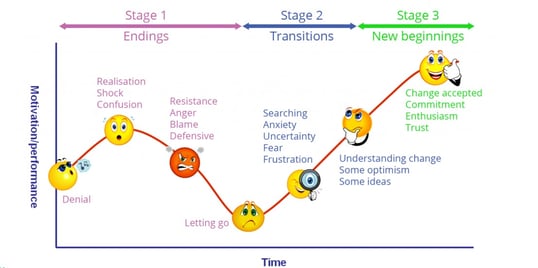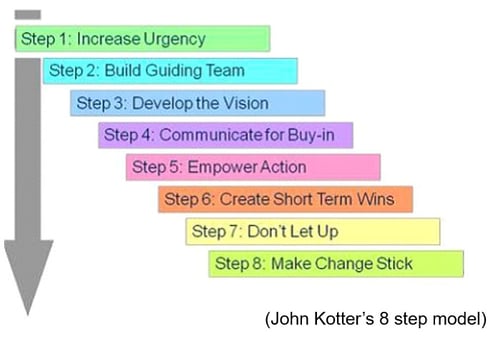As a business psychologist, I am somebody who loves change, and variety – this is demonstrated by the fact that I move house with great regularity (now managing it with military precision), and I started a new job, working with t-three during a pandemic!
However, not everybody feels comfortable changing things or even their surroundings on a regular basis. As human beings, we all encounter change or transformation differently and most of us recognise a variety of responses along the way, as we experience the various stages of the classic change curve (Kubler-Ross) whilst reasoning our way from the old to the new.

This is an important point and one that gave me a real ‘A-ha’ moment when I first started studying change leadership in more depth! If we look at the Kubler-Ross model, we can tend to assume that the beginning of the change curve (i.e., the denial stage) aligns with the beginning of the change/transformation being experienced and that this is what causes resistance. In reality, this stage is the end of what came before, which is why we need time to adjust to the loss and to see things differently. Once we have worked our way through the curve and reach the ‘change accepted’ stage, we have reached the ‘beginning’ of what comes next. Why then do we accept that change and transformation take time to achieve when dealing with scenarios in our personal lives, for example, the loss of a loved one, the loss of a job, the loss of marriage, and yet when we try to implement change and transformation in the workplace, emotions, and feelings seem to matter much less?

So, what does all this mean?
I feel that it is very relevant when thinking about why organisational change processes fail more often than they succeed. I believe that successful change or transformation is linked to individual openness to change, clarity around what the desired future state looks like, a level of trust in WHY it needs to happen, and an acceptance that for many, this is also a loss of some kind. Therefore, should we not invest time and effort in making sure that those impacted have an opportunity to share those emotions and feelings before expecting them to ‘snap out of it’ and move on to the next big thing? Of course, there are some changes that must happen quickly – take the pandemic for example. Our responses had to be lightning-fast to save lives. John Kotter states that the first two steps of successful transformation are to Create a Sense of Urgency and Build a Guiding ‘Coalition’ or Team. We often see this in a crisis, but then comes the need to Develop the Vision and Communicate for Buy-in. The communication of these messages takes time. The acceptance of these messages takes time. The embedding of the new world ethos takes time… and yet we seem to continually try to reach that ‘go live’ date as quickly as possible!
Before you can Empower Action (step 5), people need to understand the WHY of the change and begin to generate some new levels of optimism about the future. Many transformations fail because this is not done effectively. The result – the project stalls part way through because people are not fully bought in or committed and therefore, either things are taken back several paces or the project is abandoned. Making sure that we invest enough time upfront to communicate clearly and regularly is vital to success, and I don’t mean send numerous emails packed with information or running Town Halls every month. We really need to get underneath the skin of the employee population and give them a voice. That way, they can feel part of it and help to advocate or champion the transformation. So… talk to people, listen to their concerns, and then shape a plan (with them) to drive the change forward positively. Give credit when Celebrating the Short-term Wins (step 6), be determined that if the transformation is right for your business, you keep at it (step 7), and finally, when you have secured the goodwill and commitment of your people, make sure that the transformation is embedded into the very fabric of your business – making it stick (step 8).
This has been my experience of leading positive transformation, what is yours? If you would like advice, guidance or just an initial discussion, you can call us on 01954 710780 or email sayhello@t-three.com.
How would you like to start a conversation? Click on the icons below, or use our interactive video tool.